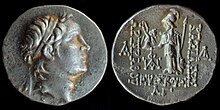Ariarathes V Eusebes Philopator (Greek: Ἀριαράθης Εὐσεβής Φιλοπάτωρ; reigned 163–130 BC) was a son of the preceding king Ariarathes IV of Cappadocia and queen Antiochis. He was distinguished by his contemporaries for the excellence of his character and his cultivation of philosophy and the liberal arts and is considered by some historians to have been the greatest of the kings of Cappadocia.[1]
| Ariarathes V "Father-Loving" | |
|---|---|
 coin of Ariarathes V | |
| King of Cappadocia | |
| Reign | 163–130 BC |
| Predecessor | Ariarathes IV |
| Successor | Ariarathes VI |
| Born | Cappadocia |
| Died | circ. 130 BC Cappadocia |
| Spouse | Nysa of Cappadocia |
| Issue | Ariarathes VI 5 other unnamed children |
| Greek | Λευκών |
| Father | Ariarathes IV |
| Mother | Antiochis |
| Religion | Greek Polytheism |

| |
| O: Diademed head of Ariarathes V | R: Athena holding Nike with wreath and resting hand on grounded shield, spear behind; ΒΑΣΙΛΕΩΣ / ΑΡΙΑΡΑΘΟΥ / ΕΥΣΕΒΟΥΣ; monograms in field |
| Silver tetradrachm struck in Eusebia 133 BC; ref.: Simonetta 2 [1];
Λ in exergue is a greek numeral and means 30th year of reign | |
Early life
editAriarathes V was the son of the king Ariarathes IV of Cappadocia, and a noble Seleucid Greek woman, Antiochis, who was the daughter of the Seleucid King Antiochus III.[2][3][4] According to Livy,[5] he was educated in Rome; but this account may perhaps refer to another Ariarathes. Rather, Ariarathes Eusebes probably spent his youth studying in Athens, where he seems to have become a friend of the future king of Pergamon, Attalus II Philadelphus.
Reign
editIn consequence of rejecting, at the wish of the Romans, a marriage with Laodice V, the sister of Demetrius I Soter, the latter made war upon Ariarathes, and brought forward Orophernes of Cappadocia, his brother and one of the supposed sons of the late king, as a claimant of the throne. Ariarathes was deprived of his kingdom, and fled to Rome in around 158 BC. He was restored to his throne by the Romans, who, however, allowed Orophernes to reign jointly with him, as is expressly stated by Appian,[6] and implied by Polybius.[7] The joint government, however, did not last long; for, shortly afterwards, Ariarathes was named as sole king.
In 154, Ariarathes assisted the king of Pergamon, Attalus II, in his war against Prusias II of Bithynia, and sent his son Demetrius in command of his forces. Ariarathes was killed in 130, during the war of the Romans against Aristonicus of Pergamon. In return for the assistance and support Ariarathes has provided to the Romans on that occasion, Lycaonia and Cilicia were added by the Romans to the dominions of his family.
Marriage and succession
editBy Ariarathes' wife Nysa of Cappadocia (who was the daughter of King Pharnaces I of Pontus) he had six children. However, all but one of the children were killed by their mother, so that she might obtain the government of the kingdom. After she had been put to death by the people on account of her cruelty, her only surviving son succeeded to the crown as Ariarathes VI of Cappadocia.
Legacy
editAriarathes was a strong philhellene; he was honoured with Athenian citizenship. He refounded the two Cappadocian towns of Mazaca and Tyana with the Greek name of Eusebia. He was generous in his donations to Athens and its institutions; an inscription remains by an association of professional actors which thanks him and his wife for his patronage. He corresponded with the Greek philosopher Carneades, as Diogenes Laërtius attests.[8]
Notes
edit- ^ Newell, Edward Theodore (1968). Royal Greek portrait coins. Whitman Publishing Company. p. 52. OCLC 697579.
... Ariarathes V was probably the greatest of the Cappadocian kings.
- ^ Gera, Dov (1998). Judaea and Mediterranean Politics, 219 to 161 B.C.E. BRILL. p. 259. ISBN 9004094415.
Antiochis, a daughter of Antiochus III, and aunt to both Antiochus V and Demetrius. Antiochis had been married to Ariarathes IV, the king of Cappadocia. At the time in question, her son Ariarathes V, the reigning king of Cappadocia asked Lysias' permission to rebury his mother's and sister's bodies in the family plot of the Cappadocian royal house.
- ^ Zion, Noam; Spectre, Barbara (2000). A Different Light: The Big Book of Hanukkah. Devora Publishing. p. 57. ISBN 978-1-930143-37-1.
Antiochus III, the Greek Seleucid Dynasty of Greater Syria captures Judea. 172 or 171-163
- ^ Glubb, John Bagot (1967). Syria, Lebanon, Jordan. Thames & Hudson. p. 34. OCLC 585939.
Although the Ptolemies and the Seleucids were perpetual rivals, both dynasties were Greek and ruled by means of Greek officials and Greek soldiers. Both governments made great efforts to attract immigrants from Greece, thereby adding yet another racial element to the population.
- ^ Livy, xlii. 19 Archived January 27, 2003, at the Wayback Machine
- ^ Appian, "The Syrian Wars", 47
- ^ Polybius, xxxii. 10
- ^ Diogenes Laërtius, The Lives and Opinions of Eminent Philosophers, iv. 64
References
edit- Appian, The foreign wars, Horace White (translator), New York, (1899)
- Hazel, John; Who's Who in the Greek World, "Ariarathes V", (1999)
- Head, Barclay; Historia Numorum, "Cappadocia", (1911)
- Justin; Epitome of Pompeius Trogus, John Selby Watson (translator); London, (1886)
- Livy; Ab urbe condita, Canon Roberts (translator); New York, (1905)
- Polybius; Histories, Evelyn S. Shuckburgh (translator); London - New York, (1889)
This article incorporates text from a publication now in the public domain: Smith, William, ed. (1870). "Ariarathes V.". Dictionary of Greek and Roman Biography and Mythology.